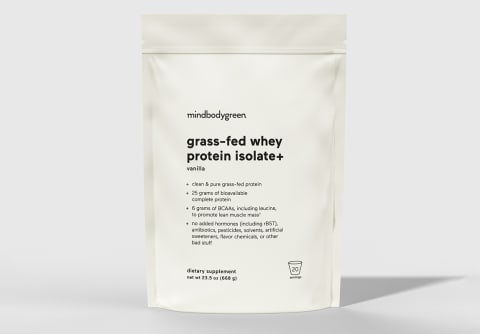Advertisement
How To Eat A High-Protein Diet Without It Becoming Your Whole Personality


A lot of us (myself included) are just learning how much protein we need to eat in a day to support optimal health. And the math for a high-protein diet is pretty simple—it’s about one gram of protein per pound of body weight1 (we get into the nuances of calculating your needs here).
Seeing seemingly large numbers like 100, 130, 160, or 200 grams appear in our heads can feel intimidating and time consuming. But you don’t have to give up your knitting (or other favorite hobby) or eat chicken breasts at all your meals to hit your goals.
Here are some tips on how to overcome this hesitation you may have toward high-protein diets and three easy tips to bump up your intake that won’t derail your daily schedule.
Overcoming your high-protein hesitations
Making any type of change to your daily routine can feel like a lot, so having reservations about making dietary changes is completely normal.
Lauren Hubert, M.S., R.D. has helped thousands of women build muscle and lose fat by prioritizing protein. “If someone is nervous that they won't enjoy their diet, I'd explore what they think a higher protein diet is,” she says. “Many women, especially, view a high protein diet as protein shakes and plain chicken breasts due to dieting trends. In reality, there is a diverse way to fit protein into meals without feeling like a gym bro.”
And if she's working with someone nervous about weight gain from eating more protein, she clarifies protein’s beneficial effects.
“More protein doesn't equal weight gain,” Hubert assures. “In fact, a higher-protein diet is crucial for fat loss and also weight management due to its appetite suppressing benefits2, the more calories you burn breaking protein down, and also protein's impact on body composition.”*
And we couldn’t agree more. We’ve talked to a lot of experts this past year about the benefits of higher protein diets for women, and have gathered their top pieces of advice for making a high protein diet enjoyable (and not like it’s your entire personality).
Take these steps to increase your protein intake
You don’t have to spend all weekend meal prepping or hours grocery shopping to set yourself up to eat 100+ grams of protein instead. Instead follow these three simple steps.
Increase portion sizes of protein-rich foods you’re already eating
The first thing you should do is identify the protein-rich foods you’re already eating (think meat, poultry, seafood, dairy, legumes, eggs, etc.). “This could look like going from 1-2 ounces of chicken at dinner to 3-4,” says Hubert.
Clinical nutritionist Kelly LeVeque previously told us you can even bump it up to 6-8 ounces a meal for an even more significant boost. To reach your total daily protein goals you likely need 30, 40, or even 50 grams of protein at each meal. For reference, 6 ounces of chicken breast3 provides just over 40 grams of protein.
Find a higher-protein alternative for foods
A lot of foods you eat likely have a higher protein substitute (that still provides a similar taste). While these changes may seem small, they can significantly increase your total protein intake by the end of the day.
Here are a few examples:
- Choose Greek yogurt over regular yogurt (for twice the protein)
- Reach for cottage cheese instead of cream cheese
- Use cow’s milk instead of almond or oat for smoothies or oats
- Choose quinoa or amaranth instead of rice
- Cook rice in bone broth vs. water
- Boil a lentil or chickpea pasta instead of wheat-based noodle
- Add collagen to your coffee instead of creamer
Incorporate a protein powder
While you don’t have to chug protein shakes, incorporating a high-quality protein powder into your routine is a simple way to quickly ramp up your intake.
When I started my 100 grams of protein a day journey, I tried a whey protein supplement for the first time and it was a game changer. I specifically leaned on mindbodygreen’s grass-fed whey protein isolate+ for an impressive 25 grams of protein per serving.
I definitely prefer a sweeter, more carb-heavy breakfast like oats, yogurt, or a smoothie, and the vanilla whey gives my breakfast a nice protein (and flavor) boost. It was exactly what I needed to balance the overall macronutrient composition of my morning meal and to keep me full until lunch.*
Depending on your preferences or dietary restrictions, you can also reach for a plant protein powder (we break down the main differences between whey and plant protein here).
Remember, protein powder is meant to complement an already protein-rich diet, not be the center of it.
The takeaway
Getting enough protein in your day-to-day may feel impossible (especially for women who previously haven’t been meeting their protein needs). But a few small tweaks to your serving sizes, food choices, and supplements can make the transition to eating a high-protein diet a breeze. Just don’t forget about fiber to make sure you stay regular during this transition.
